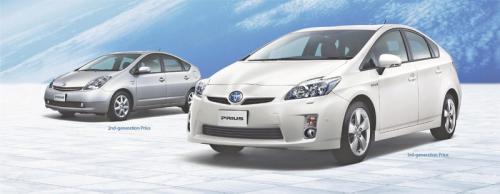How Prius became the “Cool Car”
The Prius debuted in Japan in 1997 and then launched overseas in the year 2000. Like any revolutionary new product, it took a little while to catch on. By 2003, the Prius was becoming generally recognised for what it was—the wave of the future—a “smart car” for a smarter generation.
In the early days, marketers said the Prius could never sell in the US. The critics insisted that the American consumer would never buy a fuel efficient vehicle with a 1.5 litre gasoline engine, even if actual power output took advantage of a second power source, an electric motor. And “Big” was big too—large SUVs and pickups were the hot sellers in Middle America.
So Toyota shelved the idea of exporting the Prius right away. But sales in Japan exceeded expectations. In fact, initial orders were three times higher than expected in just the first month. When a minor change model appeared in 2000, Toyota tested the waters in North America and Europe— selling 6,500 Prius vehicles abroad the first year—about half of those sold in Japan.
Another minor change, and Prius (2000) was exported to US and Europe.
Movie stars and other celebrities have often led the way in identifying progressive issues—such as climate change or the environment—and also progressive products like the Prius, which had a strong emotional resonance since it contributed to creating a more environmentally friendly world.
At the 2003 Academy Awards ceremony, all eyes were on celebrities such as Harrison Ford, Calista Flockhart, Leonardo DiCaprio and Cameron Diaz—each of them arriving at the famous Red Carpet in...a Prius! Since “cool” people used this unique vehicle, and were not shy about explaining why, Prius quickly became a ‘cool’ icon.
Prius in the Fast Lane
America is a nation in the Fast Lane. But in California where almost everyone relies on cars to get from A to B freeway congestion and air pollution issues led to carpool lanes. The government of California then decided that low emissions vehicles should get preferential treatment. Suddenly, Californians wanted the Prius.
When the second generation Prius appeared in September 2003, it was a huge step forward. Its Hybrid Synergy Drive not only benefitted the environment to a greater extent, but also offered substantial improvements in power and overall performance. This new Prius was also more stylish, inside and out—a trendy five- door hatchback with a stunning interior and Toyota’s legendary attention to details, including a joystick-like shift knob and push button start.
A winner worldwide
The second generation Prius was clearly a winner. It became “Car of the Year” in North America in 2004 and in Europe in 2005. As it caught the eye of the public globally, other manufacturers belatedly tried to get into the market. Prius, however, continued to be acknowledged as the only credible “Green Car”.
In 2008, its global sales soared to 1 million units. But Toyota did not rest on its laurels, and introduced a third generation in 2009. Sales doubled, exceeding 2m in 2010.
It is now sold in over a hundred countries and, with the advent of the new fourth generation model, it will be introduced in another thirty, including the Middle East.
Related Posts

